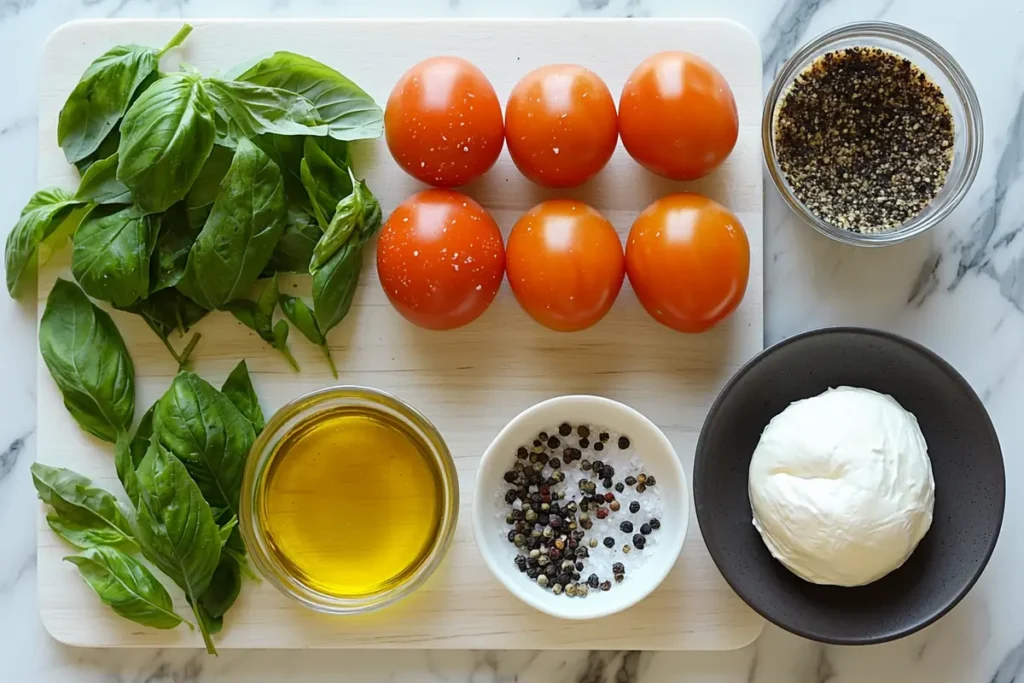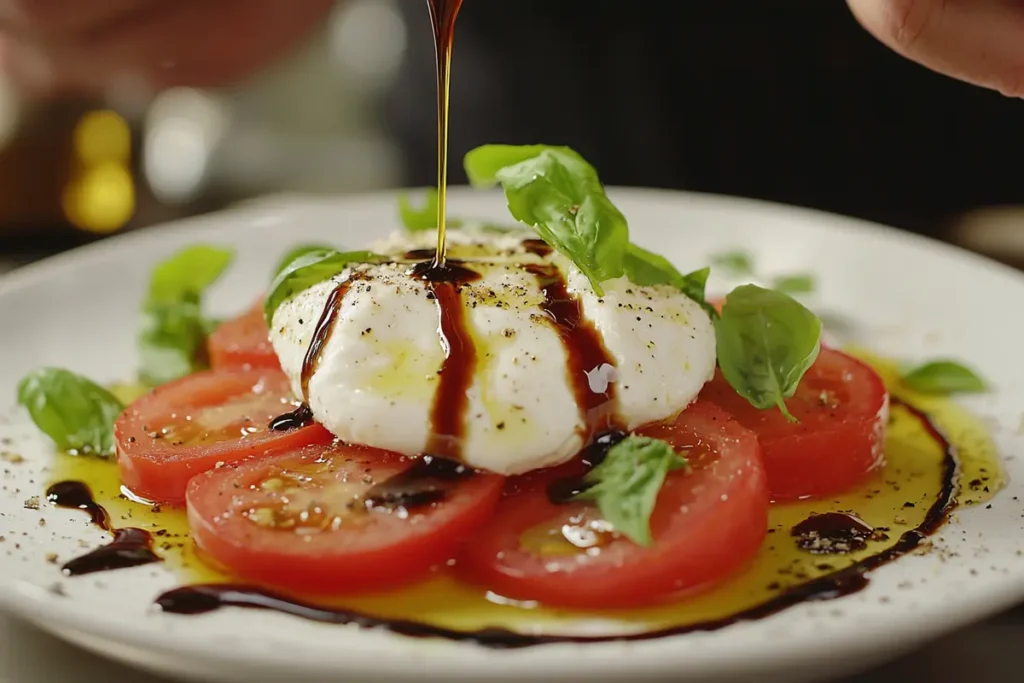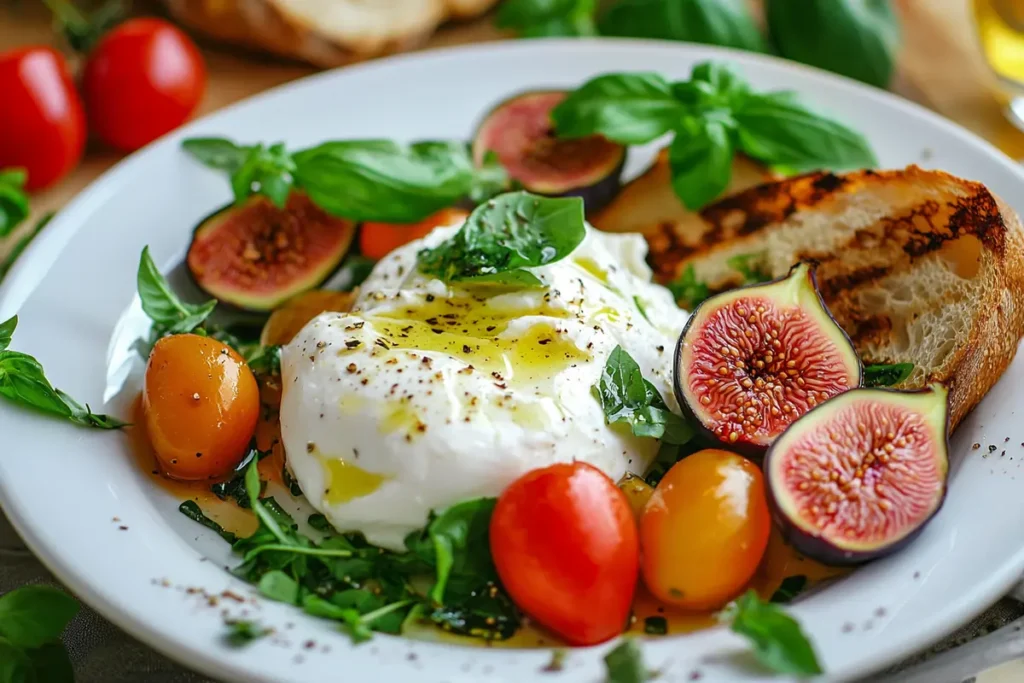If you’re searching for a dish that balances elegance, simplicity, and flavor, look no further than Burrata Caprese. This classic Italian-inspired salad brings together creamy burrata cheese, juicy tomatoes, and fresh basil in a harmony of textures and tastes. Drizzled with rich olive oil and seasoned to perfection, it’s an irresistible blend of fresh, wholesome ingredients.
What is Burrata Caprese?
The Essence of Burrata Caprese
At its heart, Burrata Caprese is an Italian salad that beautifully reinvents the traditional Caprese salad by substituting mozzarella with burrata. As a result, it offers a dish that is not only creamy and indulgent but also incredibly satisfying. Furthermore, burrata, which translates to “buttered” in Italian, is a unique fresh cheese featuring a mozzarella shell filled with a luscious mixture of cream and cheese curds. In addition to this rich and creamy centerpiece, the dish incorporates ripe tomatoes that provide a burst of natural sweetness and a juicy texture.
Why Burrata Makes a Difference
While mozzarella is undoubtedly delicious, burrata adds an extra layer of richness that elevates the dish. Its soft, creamy interior pairs beautifully with the acidity of fresh tomatoes and the fragrant sweetness of basil. The olive oil drizzle enhances these flavors, creating a salad that’s both simple and sophisticated.
A Modern Twist on a Timeless Classic
Though Burrata Caprese is deeply rooted in Italian cuisine, it represents a modern twist on the traditional Caprese salad. This variation emphasizes the importance of high-quality, fresh ingredients, transforming a humble combination into a gourmet experience. Perfect for a casual lunch, a fancy dinner, or even a picnic, it’s as versatile as it is delectable.
Ingredients and Preparation
Selecting the Best Ingredients

- Tomatoes: Choose ripe, firm tomatoes for their vibrant flavor and texture. Heirloom or vine-ripened varieties are particularly ideal, as they bring natural sweetness and juiciness to the dish.
- Burrata Cheese: The star of the show! Look for fresh burrata that’s soft and creamy on the inside. If possible, source it from a trusted dairy or specialty store to ensure the best quality.
- Basil: Fragrant and fresh basil leaves are non-negotiable. Their herbal sweetness perfectly complements the tomatoes and burrata.
- Olive Oil: Opt for high-quality extra-virgin olive oil. Its rich, fruity profile ties together all the flavors and adds a luxurious finish to the salad.
Step-by-Step Preparation Guide

- Slice the Tomatoes: Begin by cutting your tomatoes into even slices. This ensures a uniform presentation and consistent bites.
- Prepare the Burrata: Gently tear or slice the burrata. Its creamy interior should remain intact to showcase its soft texture.
- Assemble the Salad: Arrange the tomato slices and pieces of burrata on a serving platter. Alternate them for a visually appealing layout.
- Add Basil Leaves: Scatter fresh basil leaves generously over the top. The burst of green adds both flavor and color.
- Drizzle Olive Oil: Finish with a drizzle of olive oil, ensuring each ingredient gets a touch of this liquid gold.
- Season: Sprinkle with a pinch of flaky sea salt and freshly ground black pepper to enhance the dish’s natural flavors.
Variations and Additions
- Balsamic Glaze: A drizzle of balsamic glaze adds a sweet and tangy contrast to the creaminess of the burrata.
- Arugula: Toss in some fresh arugula for a peppery bite and extra greens. It’s a great way to add depth and texture to the salad.
- Pesto: Swap out fresh basil leaves with a dollop of basil pesto for a richer, nutty flavor.
- Seasonal Fruits: Consider adding slices of peaches or figs for a sweet, seasonal touch that pairs beautifully with the cheese.
Nutritional Benefits of Burrata Caprese
Burrata Caprese is not just a treat for your taste buds—it’s a dish that brings a wealth of nutritional benefits. Thanks to its fresh, wholesome ingredients, this salad is as nourishing as it is delicious.
At the heart of the dish, burrata cheese provides an excellent source of protein, calcium, and healthy fats. These nutrients support muscle repair, bone health, and energy levels, making burrata a satisfying choice in moderation. The creaminess of burrata also delivers a dose of conjugated linoleic acid, a compound linked to potential heart health benefits.
Tomatoes, another key ingredient, are packed with antioxidants like lycopene, which is known for its role in promoting skin health and reducing the risk of certain chronic conditions. Tomatoes are also rich in vitamins A and C, helping to boost immunity and improve vision.
Fresh basil contributes its own set of perks. It’s a great source of vitamin K, which is essential for blood clotting and bone strength, as well as a variety of antioxidants that help combat inflammation.
Finally, the drizzle of olive oil brings heart-healthy monounsaturated fats and polyphenols, which support cardiovascular health. Together, these ingredients make Burrata Caprese a nutritious option that’s perfect for a balanced, wholesome diet.
| Nutrient | Amount (Per 100g) | Daily Value (%) |
|---|---|---|
| Calories | 250 kcal | 12% |
| Protein | 9 g | 18% |
| Fat | 21 g | 32% |
| Saturated Fat | 9 g | 45% |
| Carbohydrates | 4 g | 1% |
| Fiber | 1 g | 4% |
| Sugars | 2 g | — |
| Calcium | 150 mg | 15% |
| Vitamin C | 10 mg | 12% |
| Vitamin K | 20 µg | 25% |
Serving Suggestions and Pairings
Ideal Occasions for Serving Burrata Caprese
Burrata Caprese is a dish that adapts effortlessly to various occasions. Its fresh and vibrant flavors make it an ideal choice for summer picnics, where light and refreshing foods are a must. Similarly, it shines as a sophisticated appetizer for an Italian-themed dinner, setting the tone with its elegant presentation and rich yet balanced taste.
Hosting a casual brunch? Burrata Caprese can easily serve as a standout side dish that pairs beautifully with other seasonal offerings. Even for a quick weekday lunch, this salad offers a simple, no-cook solution that’s both satisfying and nutritious. Its versatility ensures it remains a favorite, whether for an intimate gathering or a festive celebration.
Complementary Dishes

- Crusty Bread: Use a slice of artisan bread to scoop up the juicy tomato and olive oil mixture for a satisfying bite.
- Grilled Vegetables: The smoky, charred flavors of zucchini, eggplant, or bell peppers create a delightful contrast to the creamy burrata.
- Seasonal Fruits: Add fresh peaches or figs for a sweet, juicy twist that balances the savory cheese.
Customizing Your Pairings
- Swap crusty bread for gluten-free options for a dietary-friendly pairing.
- Incorporate roasted seeds, such as pumpkin or sunflower, for added crunch and nutrition.
- Add a drizzle of infused olive oil, like garlic or rosemary, to elevate the dish’s complexity.
Frequently Asked Questions
What is the difference between burrata and mozzarella balls?
While both cheeses are made from cow’s or buffalo’s milk, the texture and flavor set them apart. Mozzarella is firm and consistent throughout, while burrata is a unique creation: a soft mozzarella shell filled with a creamy mixture of stracciatella and cream. This luxurious interior makes burrata richer, softer, and more decadent than mozzarella.
What is the best way to serve burrata?
The best way to serve burrata is at room temperature, which allows its creamy interior to shine. Drizzle it with high-quality olive oil, sprinkle it with a pinch of flaky sea salt, and pair it with fresh produce, like tomatoes and basil, to bring out its delicate flavor.
Can I prepare Burrata Caprese in advance?
While it’s best enjoyed fresh, you can prepare the components ahead of time. Slice the tomatoes, wash and dry the basil leaves, and store them separately. Assemble the salad just before serving to preserve the burrata’s creamy texture and prevent the tomatoes from releasing too much moisture.
Is Burrata Caprese gluten-free?
Yes, Burrata Caprese is inherently gluten-free, as its core ingredients—burrata, tomatoes, basil, and olive oil—contain no gluten. If serving it with bread, opt for a gluten-free option if necessary.
How should I store leftover burrata?
To maintain its freshness, store leftover burrata in its original brine in an airtight container. Refrigerate it and consume within 24-48 hours. Avoid freezing burrata, as it can compromise its creamy texture.
Can I use other cheeses besides burrata?
Absolutely! If burrata isn’t available, fresh mozzarella or buffalo mozzarella are excellent substitutes. While they won’t replicate the creamy interior of burrata, they still offer a satisfying texture and mild flavor.
What tomatoes are best for Burrata Caprese?
The best tomatoes for Burrata Caprese are heirloom or vine-ripened varieties. Their sweetness, juiciness, and vibrant color perfectly complement the creamy burrata and fresh basil. Always choose tomatoes that are firm yet ripe for optimal flavor and texture.

Burrata Caprese: A Fresh Take on the Classic Italian Salad
- Total Time: PT10M
- Yield: 2 servings
- Diet: Vegetarian
Description
This Burrata Caprese is a fresh, vibrant salad made with creamy burrata cheese, ripe tomatoes, fragrant basil, and a drizzle of rich olive oil and balsamic glaze. It’s quick to prepare, beautifully simple, and bursting with the classic flavors of Italy—perfect for a light lunch or elegant appetizer.
Ingredients
-
1 ball (125g) fresh burrata cheese
-
2 large vine-ripened tomatoes, sliced
-
8 fresh basil leaves, whole or thinly sliced
-
2 tablespoons extra-virgin olive oil
-
1 tablespoon balsamic glaze (optional, for drizzling)
-
Salt, to taste
-
Freshly ground black pepper, to taste
-
2 slices crusty bread (optional, for serving)
Instructions
-
Wash and slice the tomatoes into medium-thick rounds and arrange them on a serving plate.
-
Gently place the burrata cheese in the center of the tomato slices.
-
Scatter fresh basil leaves over the top.
-
Drizzle with extra-virgin olive oil and, optionally, balsamic glaze.
-
Sprinkle lightly with salt and freshly ground black pepper.
-
Serve immediately with toasted bread if desired.
Notes
Variations: Try adding sliced peaches, figs, or arugula for a seasonal twist.
Allergy Advice: Contains dairy. Choose gluten-free bread for gluten intolerance.
Tips: Let burrata sit at room temperature for 15–20 minutes before serving to enhance creaminess.
- Prep Time: PT10M
- Cook Time: PT0M
- Category: Lunch
- Method: No-cook
- Cuisine: Italian, Mediterranean




